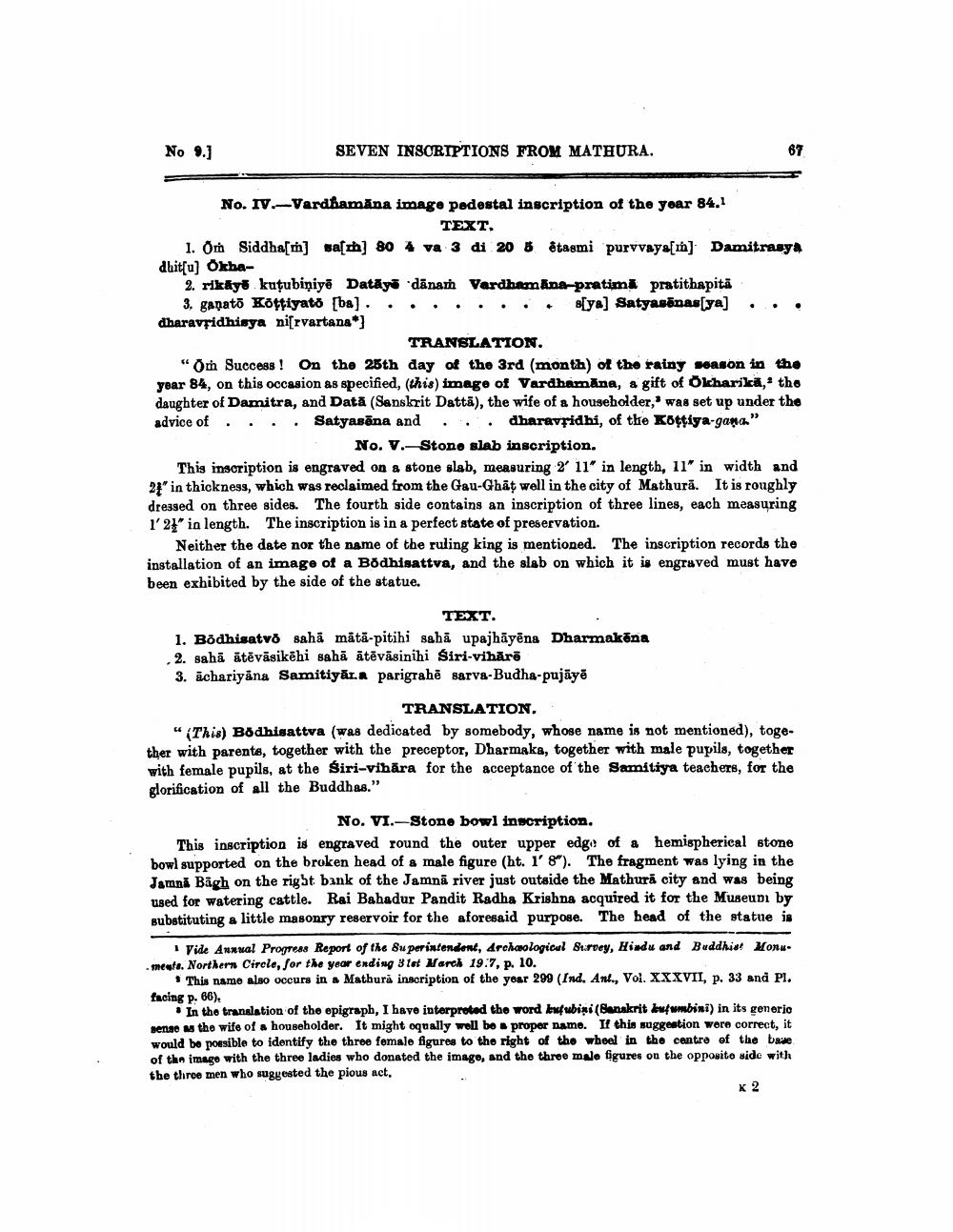________________
No 9.]
SEVEN INSCRIPTIONS FROM MATHURA.
No. IV.-Vardham na image pedestal inscription of the year 84.1
TEXT. 1. Om Siddha[m] salth] 80 4 va 3 di 20 8ētasmi purvvays[m] Damitrasya dhit[u] Okha
2. rikayo kuțubiņiyē Datāya dānam Vardhamana-pratimk pratithapitā
3. ganato Kottiyato [ba] . .. .. .. .. B[ya] Satyasõnas[ya) . . . dharavşidhisya ni[rvartana]
TRANSLATION. « Om Success! On the 28th day of the 3rd (month) of the rainy season in the year 84, on this occasion as specified, (this) image of Vardhamana, a gift of Olharikā, tho daughter of Damitra, and Data (Sanskrit Dattā), the wife of a householder,' was set up under the advice of . . . . Satyasõna and ... dharavridhi, of the Kottiya-ganan."
No. V. Stono slab inscription. This inscription is engraved on a stone slab, measuring 2' 11' in length, 11" in width and 27 in thickness, which was reclaimed from the Gau-Ghät well in the city of Mathură. It is roughly dressed on three sides. The fourth side contains an inscription of three lines, each measuring 1'21" in length. The inscription is in a perfect state of preservation.
Neither the date nor the name of the ruling king is mentioned. The inscription records the installation of an image of a Bodhisattva, and the slab on which it is engraved must have been exhibited by the side of the statue.
TEXT. 1. Bodhisatvð sahā mātā-pitihi sahā upajhāyēna Dharmakana 2. saha ātēvāsikēhi sahā ātēväsinihi Siri-viharë 3. achariyana Samitiyām.a parigrahē sarva-Budha-pujāyo
TRANSLATION. "(This) Bodhisattva (was dedicated by somebody, whose name is not mentioned), together with parents, together with the preceptor, Dharmaka, together with male pupils, together with female pupils, at the Siri-vihāra for the acceptance of the Samitiya teachers, for the glorification of all the Buddhas."
No. VI.-Stone bowl inscription. This inscription is engraved round the outer upper edg of a hemispherical stone bowl supported on the broken head of a male figure (ht. 1' 8"). The fragment was lying in the Jamni Bagh on the right bank of the Jamnā river just outside the Mathura city and was being used for watering cattle. Rai Bahadur Pandit Radha Krishna acquired it for the Museum by substituting a little masonry reservoir for the aforesaid purpose. The head of the statue is
Vide Anxual Progress Report of the Superintendent, archeologicul Survey, Hindu and Buddhis! Yorumeste. Northern Circle, for the year ending 3 fet March 19.7, p. 10.
This name also occurs in a Mathura inscription of the year 299 (Ind. Ant., Vol. XXXVII, p. 33 and PI. facing p. 66).
In the translation of the epigraph, I have interpreted the word by bişi (Banskrit lufumbini) in its generio sense as the wife of a householder. It might oqually well be proper name. If this suggestion were correct, it would be poesible to identify the three female figures to the right of the wheel in the centre of the base of the image with the three ladies who donated the image, and the three malo figures on the opposito side with the three men who suggested the pious act.




